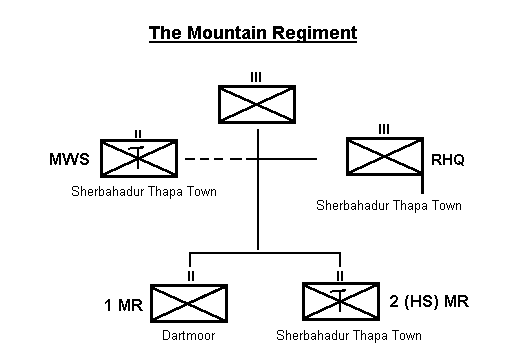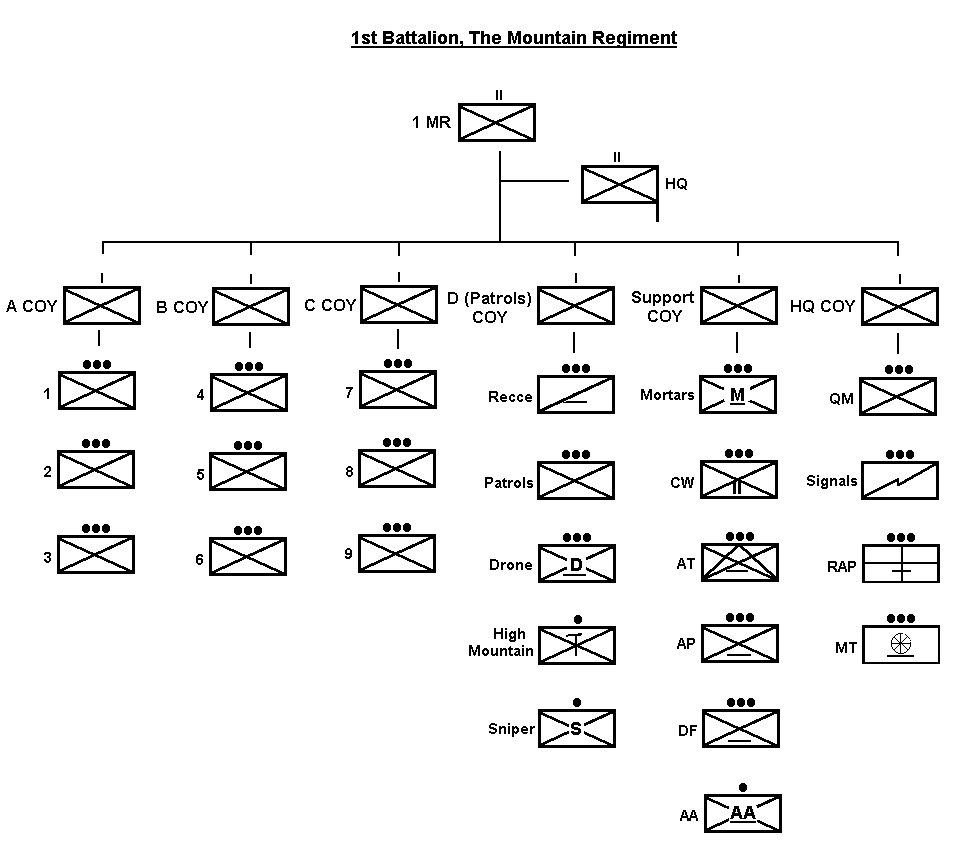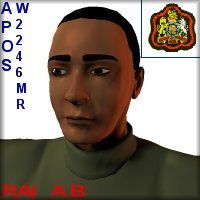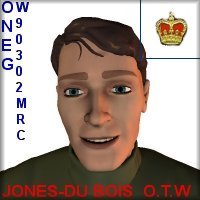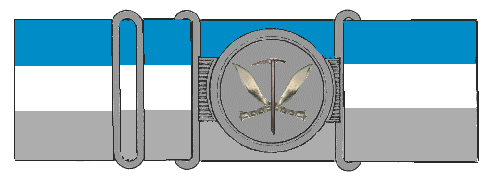Wellon Army: 2300AD
The Mountain Regiment Introduction The Mountain Regiment, or MR, is a crack infantry regiment of the Wellon Army. It is recruited from the Pendragon Mountain region and many of its soldiers are descendants of the early Gurkha garrisons of the region. The MR is renowned for its high standards of physical fitness and fieldcraft combined with its mountain warfare skills. The MR is a small regiment whose 1st Battalion is assigned to the testing mountain and arctic warfare role with 4 Light Brigade, although it has served frequently in the jungles of the South. The 2nd Battalion is a Home Service formation that provides mountain rescue cover to the Pendragons as well as support to the Mountain Warfare School and maintaining the standards of the whole regiment. Although it has not seen wartime action and seems unlikely to be deployed with the Wellon Expeditionary Force, the Mountain Regiment has a surprising influence across the Wellon Army as a whole. Narrative Lance Corporal Katie Skotak walked unarmed towards the welcoming light of a fire through the swirling blizzard. The twisted shape of the crashed Sno-skimma loomed up in front of her out of the white-out. A small, bedraggled group of people huddled in its lee trying to gain as much warmth as they could from the fire. They took a couple of seconds to notice that she was there. They were a small group of Tiranian nationalists who had come into the Wellon Arctic Territories to plant Tiranian and American flags on the North Ridge. This had become recently popular as a show both of Tiranian patriotism and a protest about 'British occupation' of parts of the Boreal continent. These incursions were running at three or four a week and recce elements of 4 Light Brigade usually kept an eye on them from a distance. Unfortunately some were badly equipped and prepared hiring Sno-skimmas in a border town and doing the run in less than a day took few precautions. 'Evening,' Skotak crouched down by the burner warming her hands. The Tiranians startled a bit, realising that they'd been found inside Wellonese territory by someone obviously a soldier. A couple of them were armed, sensible to ward off the White Afanc and made no move towards their weapons. 'So what happened?'
As she talked a Reynard nosed out of the blasting snow. The noise of its approach muffled by the blasting wind even as the engine fought to keep it firmly attached to the ground. Three heavily swaddled figures manned the enclosed vehicle. They disembarked quickly un-stowing shelters and survival kit. Almost another typical patrol with the 1st Mountain Regiment in the far North.
The Pendragon Mountains stand at the heart of the Tiralbion. It is a vast region of stunning beauty, remote isolation and considerable mineral wealth. The foothills and outer edges of the region are increasingly accessible and are areas whose populations have been swelled by tourism and mining in the last 50 years. However the central plateau, the High Pendragons, is still isolated from the rest of Wellon and has poor communications links. The High Mountains are an area dominated by huge peaks, dense forests and deep hidden valleys. There are vast tracts of the plateau which have never been visited by humans although the highest peak, Arthur's Crown, is a mecca for climbers from across the Core. The weather is harsh, especially during the winters and is positively extreme in a Grandwinter when little movement can take place in the High Mountains. The region has a population of around 2 million people scattered across it, and those 400 000 or so that live in the High Mountains have developed their own culture, traditions and superstitions. They are renowned for their independence and self-sufficiency as they are far from the social security safety nets of the more developed parts of Wellon. (Although they are linked of course to the Data Net through satellite communications.) The history and development of the region is central to the story of the Mountain Regiment which recruits from the area and provides many of its inhabitants with their only link to the world outside of the Mountains. As the first wave of colonial settlement commenced in the Tiralbion, the North Albion Plain was one of the major areas of development. City-hubs sprung up at Victoria and Mont Royal whilst forestry provided building materials and the fertile plains were ideal for agriculture. Unfortunately in 2187 a change occurred in British emigration policy to Tirane, ending the previously stringent training and selection procedure. This resulted in a renewed flood of colonists mostly from the deprived and overcrowded cities of the British Isles, many of whom lacked even the basic skills required for survival in a developing colony. This resulted in an rapid increase in urban crime and rural banditry that took hold especially in North Albion and New Scotland. In the mid-2190s the problem had reached its peak in North Albion and the paramilitary British Tirane Police was reinforced with British Army forces and locally raised auxiliaries. These harsher measure succeeded in suppressing the problem but many of the more dedicated bandits grouped together in the foothills of the Pendragons where they preyed on the few isolated communities and held logging and mining operations to ransom. The Governor of North Albion decided to bring in the military to deal with a problem well beyond the abilities of the BTP, instead he was able to deploy two Gurkha battalions in the area. These accomplished soldiers were the first of many who would serve in the mountains. Through the last decade of the 22nd century and the first two of the 23rd a low intensity war was waged in the picturesque Pendragons which forced the bandits into the High Mountains. The more violent groups were hunted down and eliminated whilst other groups, who became known as Mountaineers, settled on the plateau and took up a less dangerous life farming and mining. Although they always maintained an edge of roguishness which the authorities never truly trusted. The Gurkhas too left their mark on the area and units of the Royal Gurkha Rifles were supplemented and occasionally replaced by Independent Gorkha Rifles. Armed compounds were established at key points and once accompanied tours were allowed Gurkha families began to settle in the area. The Gurkha compounds in the High Mountains became small towns, trading hubs for the scattered villages and settlements in the sounding area. A number of Gurkha battalions were raised for service in North Albion for whom land grants and settlement rights in the area at the end of service were written into the contract. This became a major attraction for soldiers from an increasingly crowded Nepal suffering political instability and coming increasingly under the influence of Manchuria. From these two originally opposed groups the population and character of the Mountains began to form. By 2219 the campaign in the Pendragons was all but over, only a small number of militant settlements still conducted banditry but these found the slim pickings and the reprisals barely worth the effort. The High Pendragons forged a unique character in its inhabitants as it was a harsh existence amidst the beauty and indeed some communities would vanish without trace during the worst winters. The settlements conducted small scale mining, farmed what crops they could on the high meadows and herded a mixture of goats and local animals. They hoped to make enough to survive the winters, trading the excess in the towns for luxuries and extra food. They would then spend the winters cut off in their small communities with only satellite TV and educational programmes to link them to the outside world. Most of the military forces had been reassigned away from the Pendragons to resume normal service, and the North Albion Gurkhas reduced to a single battalion in the Royal Gurkha Rifles, which the British wanted to reassign to service elsewhere. Law and order was placed in the hands of the British Tirane Police and the local police force but they proved too few and too widely spread to be particularly effective. Instead the British Army decided to raise a reserve garrison battalion from the local population. From the start it was obvious that the intention was for a unit primarily drawn from retired Gurkhas in the region, however what resulted was somewhat different. In the spring of 2225 after a winter in which the media and word of mouth passed the news of the formation of the new unit across the High Mountains. A gathering of potential recruits was to take place in the Compound of Lachhiman Gurung Town, the largest settlement in the region. The response was beyond what the army had expected, as not only those of Nepali descent had arrived but also many from former bandit communities. They were mostly young men drawn to enlisting mostly by the prospect of adventure and the chance of escaping the restricted lifestyle in their villages. Although some of the old school officers in charge of raising the new unit worried about recruiting Mountaineers they were entered into the recruitment process. Run by a mixture of Gurkha Rifles officers and NCOs the new unit ran a selection process for young soldiers that was almost identical to mountain selection in Nepal, whilst retired Gurkhas were accepted straight back into the unit. The selection course results came as something as a surprise as young 1st generation Wellonese Nepalis were matched by the young 1st generation Wellonese Mountaineers. However by the end of the week the new unit had recruited enough suitable potential soldiers to begin the formation of two companies of troops. In addition other detachments could be formed by recruiting ex-Gurkha soldiers. Known initially as the 1st Mountain Battalion it took several years to be recruited up to strength, but it deployed its companies and detachments to compounds across the region allowing the final British Army garrisons to be withdrawn from the area. Anti-bandit operations in support of the BTP were relatively uncommon, but the battalion developed a search and rescue capability that was much in use during the winter months. However this job was not without its casualties and many soldiers of the battalion would die over the years trying to rescue others. During the summer months the battalion would send out patrols across the region keeping contact with the more remote settlements. Although out of sight of most of the British Army and not even a part of the North Albion Defence Force the battalion started to make an impact outside its region. The battalion developed a number of alpine warfare courses which British and North Albion soldiers were open to attend. These were of very high quality and exceptionally testing and began to develop a reputation for the battalion. In 2231 a company from the battalion was deployed to the Southern Archipelago, and once it had adjusted to the conditions it impressed the RGR battalion it was deployed with. In 2241 the Territories of the Tiralbion were combined to form the Dominion of Wellon. At the same time a unified Wellon Defence Force was created from the three Territorial Defence Forces and some Tiranean units of the British military. The 1st Mountain Battalion was one of these units transferred and upon transferral was renamed as The Mountain Regiment with a single battalion. However this had relatively little effect on the daily operation of the unit to begin with, the main difference was no instead of being trained by the regiment recruits were to be sent to a centralised depot and trained with other recruits from across North Albion. The high quality of recruits to the MR was soon obvious to the Wellon Army, although the regiment complained about the general quality of training at Narvik Garrison and implemented supplementary programs. Increasingly companies from the MR were deployed on exercises with other units and were found to be excellent soldiers on an individual level but lacking experience and expertise in working with other units and support arms. This impression was reinforced by the operational deployment of MR company groups in the Southern Archipelago. In 2254 the WDF made a decision that the 1st Battalion of the Mountain Regiment was to become a light role battalion and would serve with a conventional brigade of the Wellon Army. A second battalion would be raised to take over the MR's tasks in its home region, to act as a depot and to support a newly expanded Mountain Warfare School to be located in the Pendragons. To accomplish this the MR had to widen its recruiting net outside of the High Pendragons and into the foothills where most of the Gurkha descended families had settled. However the character of the Mountain Regiment remains rooted in the High Mountains. 1 MR swiftly took to its new role, although it didn't always make friends with the other battalions in the brigade. The Mountain Regiment soldier is characterised by robustness, self-reliance, teamwork and a healthy disrespect for un-proven authority but they are also clannish, suspicious of outsiders and scornful of those who don't meet their standards. 1 MR proved excellent in small unit training often severely embarrassing other units in force on force manoeuvres and their lack of modesty often sparked fights in the pubs and clubs. 1 MR was often given a spearhead role and served frequently in the South. In addition it received many training opportunities in a variety of Wellon's geographical conditions to make the best of its capability in small unit operation. From 2263 on its formation the battalion became a part of the 1 (Wellon) Light Brigade and would always serve in the 2nd Light Division when it came into being. It has never served as a mechanised or armoured battalion. Since 2283 it has been a component battalion of the independent 4 (Wellon) Light Brigade which is tasked with mountain and arctic warfare and trains extensively in the Pendragons and the Wellon Arctic Territories. This is a role for which 1 MR is almost perfectly suited. Today the Mountain Regiment stands as one of the finest infantry units of the Wellon Army. This status is little recognised outside of the ranks of the army and media commentators look instead to the more glamorous Royal Wellon Marines or Royal Wellon Airmobile Regiment. However the regiment's excellent raw material of fit, self confident and well educated (there is little else to do during Pendragon winters than learn) recruits has combined with a comprehensive training regime to produce fine infantry soldiers. The regiment has only seen action in only minor skirmishes on internal security missions, however the standards it sets are a major influence on the rest of the Wellon Army. The MR recruits primarily from the Pendragon Mountain region, although it does accept recruits from outside the region. The regiment also accepts some soldiers transferring from other parts of the Wellon and other Commonwealth Armies, providing they come up to the Mountain Regiment's strict standards. A majority of the MR's recruits are of Nepali and Gurkha descent and are predominantly the sons and grandsons of the Gurkhas who settled in the region after their military service. However the regiment is not ethnically exclusive and some 45% are of non-Nepali origins. These are primarily people whose families had settled in the region after the 2200s when the worst of the banditry problems had been stamped out. However a strong minority of recruits can trace their roots to communities of bandits the Gurkhas were brought into suppress. Regardless of their origins the people of the Pendragons are a fiercely independent bunch mindful of their own traditions and this has carried over to the regiment. To have a son or daughter serving in the Mountain Regiment is a matter of pride and carries great kudos in the small towns of the High Pendragons. Consequently service has become something of a family tradition in many areas, and veterans of the regiment are often prominent in business (including tourism) and local government. Those recruited from outside of the Pendragons, roughly 20%, are normally those of Nepali descent who want to follow family tradition and join the regiment. Other recruits are often keen mountaineers and climbers drawn by the Mountain Regiment's reputation. Trained soldiers transferring into the regiment normally come from soldiers of the Royal Gurkha Rifles wishing to settle in Wellon, although soldiers from across the Commonwealth can be found in the ranks of the MR. Although very sparsely populated the Pendragons are a rich recruitment area for the Wellon Army. In addition the British 5 RGR (descended from the old North Albion Gurkhas) also have a recruiting team in the area which creams off a small but significant proportion of recruits every year. Nevertheless the Mountain Regiment is usually three times oversubscribed with potential recruits every year, consequently with the Royal Wellon Marines it is the only Wellonese unit that runs a recruit selection course. This week long course relies upon hill walking and mountaineering to assess the calibre of the recruits, those that fail this gut-busting course cannot join the MR but can go onto join any other Wellonese unit. It is acknowledged that the course favours those raised in the Pendragons over potential recruits from elsewhere on Wellon. (Although it is rated as less physically, although more mentally demanding than the RGR's Selection process.) It should be noted that the proportion of female soldiers in the Mountain Regiment is far below the average levels in most Wellonese infantry regiments. This is due to two factors, the most obvious are the very tough physical demands of joining a crack unit. The second factor is the very low proportion of female recruits from the Nepali descended community caused by discouragement by family and friends about moving into what is still seen as a male preserve. However those Nepali descended women soldiers who have made into the MR are acting as trailblazers for a slowly increasing number of female recruits. Conditions of service within the MR are somewhat different than the rest of the Wellon Army. Enlistment must be either as a Permanent Force or Home Service (Local Permanent Force) soldier, however once the soldier has successfully completed the full training course the HS soldier can then revert to Volunteer Force status whilst serving with the 2nd (HS) Battalion. The Mountain Regiment undertakes its Phase 1 training at the spartan Stronghold Caserne 500 miles south of Mont Royal in the foothills of the Pendragons. Although training is unified there are normally only a few RWN or RWAF or indeed non-MR recruits, consequently Phase 1 at the Stronghold is more of a dedicated infantry course than that undertaken at other depots. This has caused some complaints from the other services in the past and attempts have been made to tone down the intensity of this training. Phase 2 is also undertaken at Stronghold Caserne at the Lord Heller's Infantry Training Centre. At this stage the MR recruits are joined by recruits from the other parts of the Division: the Royal Wellon Marines, Royal Wellon Airmobile Regiment and Desert Reconnaissance Force. As befits the specialised nature of these troops training at LHITC is very testing, most of the field training is done in the darkly forested hills of this sparsely populated area. However the recruits are also deployed across Wellon on exercises in desert, maritime and arctic conditions. Phase 2 lasts some 6 months and drop out rates for MR recruits run at 33% (significantly superior to those of the other regiments at LHITC) many failures are caused by injury and the recruits subsequently pass the course after rehabilitation. The Mountain Regiment runs its own unique Phase 3 course, known as the Mountain Trooper Course. This is undertaken at the Mountain Warfare School located alongside the MR RHQ and 2 MR HQ at Ganju Lama Barracks near Sherbahadur Thapa Town in the High Pendragons. The soldier who has just completed Phase 2 is posted to the 2nd (HS) Battalion whilst he undertakes the Mountain Trooper Course. MTC concentrates on teaching the young soldier specialist mountain warfare techniques, search and rescue drills and survival skills. The Mountain Warfare School is far from any bright lights or sin strips common to military garrisons the world over, consequently the training is unrelenting. Many soldiers come to regard themselves as 'warrior monks', however the Mountain Regiment soldier produced at the end of this 14 month process is one of the fittest and finest trained in the Wellon Army. Once the soldier has successfully completed the MTC he will normally be assigned to the 1st Battalion serving as part of 4 (Wellon) Light Brigade stationed near Dartmoor. However this requires the soldier to undertake the Para Battle Cadre and associated courses to qualify fully for the brigade's intervention role. After the previous years worth of training the Para Battle Cadre is relatively simple and MR troopers have a very low failure rate. PF soldiers would expect to return to the 2nd Battalion at several times during their service to conduct further training, as instructors or as members of a mountain rescue team. MR soldiers will expect to undertake the Mountain Leader Course before making corporal and the Mountain Instructor Course on making sergeant, officers will also undertake these courses during their career. This gives the entire regiment a thorough grounding in these techniques. It also creates a bond throughout the regiment that all of its members are fit enough and can be relied on without question. The MR does not run special training cadres for soldiers attending the Royal Military Academy, it is presumed that if the soldier has been chosen to undertake any course at RMANC they will be capable of passing it with flying colours. If not they better have a very good explanation or their remaining time in the regiment will be short once they return. Officer recruitment is undertaken almost exclusively from within the battalion's ranks and that only after two years service will a candidate be considered, as by then they will be deemed to have met the basic standards. Although the officer selection process is fairly conventional the Mountain Regiment allows any of its members to anonymously veto or 'blackball' an officer candidate. However these 'blackballs' are relatively rarely used (although their was a spate of family feud inspired incidents in the '70's) the right of even the junior most soldier to veto an officer candidate is fundamental to the esprit de corps and mutual trust of the regiment. A blackballed officer candidate can choose to remain within the ranks of the regiment or seek commission with another regiment without prejudice, indeed two serving General officers were blackballed candidates with the Mountain Regiment. This exclusivity has led to a shortage of officers within the regiment and Colour Sergeants run most platoons. The Mountain Regiment is composed of two infantry battalions, one Permanent Force and one Home Service. These are controlled administratively by the Regimental HQ which in turn answers to the Lord Heller's Division and the Corps of Infantry. Associated with the regiment, although no longer and integral part of the unit, it the Mountain Warfare School co-located with RHQ and 2 MR and drawing on their resources.
1st Battalion, The Mountain Regiment 1 MR is a conventionally organised light infantry battalion. It is attached to 4 (Wellon) Light Brigade, an independent brigade under the operational command of the Strategic Reserve. 4 Light Brigade is primarily tasked with the conduct of mountain and arctic warfare as well as littoral and airmobile intervention operations. In addition the brigade is able to carry out low intensity operations and internal security duties. The brigade is stationed at Campbell Barracks near Dartmoor and does quite a lot of training in the Arctic Territories. The unspoken assumption is that the brigade would deploy to Knightsbridge should tensions with Tirania over the territories accelerate. The battalion is composed of four rifle companies (one dedicated to recce tasks), a support company and a HQ Company. The battalion has at its disposal an array of vehicles and methods of transport that can be called upon depending on the conditions which it may have to face. The main ACV is the WMV Reynard III, a robust long ranged tactical transport, for other occasions the light Quad prime mover can be utilised whilst the go-anywhere Redkat is also availible. One change of organisation is the addition of the High Mountain Platoon in D (Patrols) Company, normally maintained on a cadre basis it provides the battalion with specific technical alpine warfare expertise. The primary feature of the battalion's organisation is flexibility, without which it is too light to survive on the battlefield or to swing roles with enough speed. As a light role battalion they have the benefit of some of the most liberal training budgets and opportunities. 1 MR tends to make the most of these opportunities and is renowned for its frequent training exchanges with mountain troops from other Tiranean nations. 1 MR was one of the first Wellonese battalions to receive combat walkers in 2297 and a cadre from the unit had been training on Earth with the Royal Marines in anticipation of this event. Consequently the 24 Bowman-B's were soon in effective service. However the 1 MR CW Platoon along the other CW unit of the brigade has been attached to the 7th Battle Group soon to deploy to Crater. They have re-equipped with specially converted Bowman-A's and have been exercising hard in the Blight with the rest of the Battle Group. |


